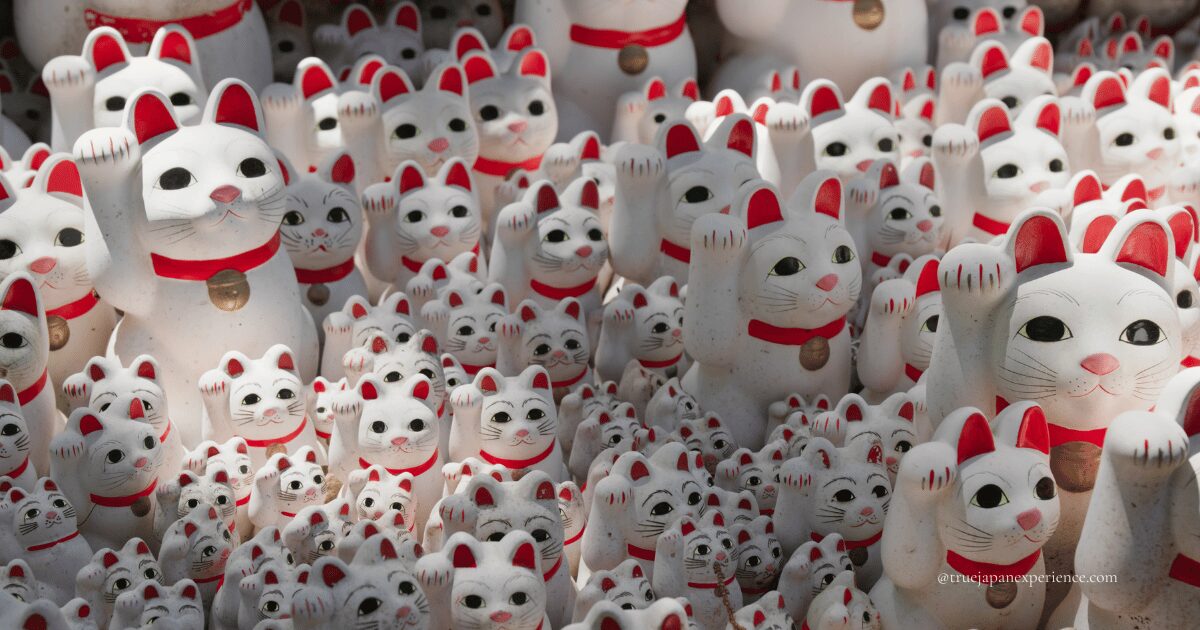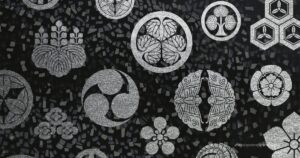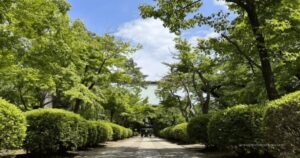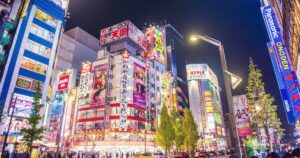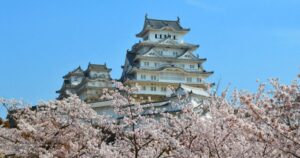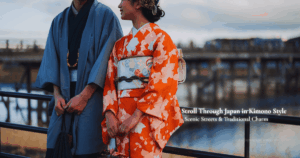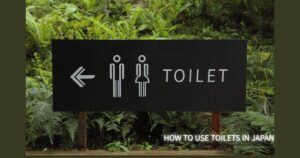Have you ever seen a cat statue with one paw raised, standing at the entrance of a shop or on a street corner in Japan?
That is the Maneki-neko, or “Beckoning Cat.”
For many years, people have loved it as a lucky charm that brings good luck and business success. Today, it is famous all over the world as the “Lucky Cat.”
In this blog, we will look at the history and origin of the Maneki-neko, the meaning of its colors and designs, and famous places in Japan where you can meet them. Let’s explore the deep and charming world of the Lucky Cat together!
Basic Information About the Maneki-neko
The Maneki-neko, also known as the “beckoning cat,” is a traditional Japanese lucky charm believed to bring happiness and good fortune.
Often seen at shop entrances and in homes, this charming cat has a unique gesture and a long history. In this section, we will look at what the Maneki-neko is and explore its origins and the stories behind it.
What is a Maneki-neko?
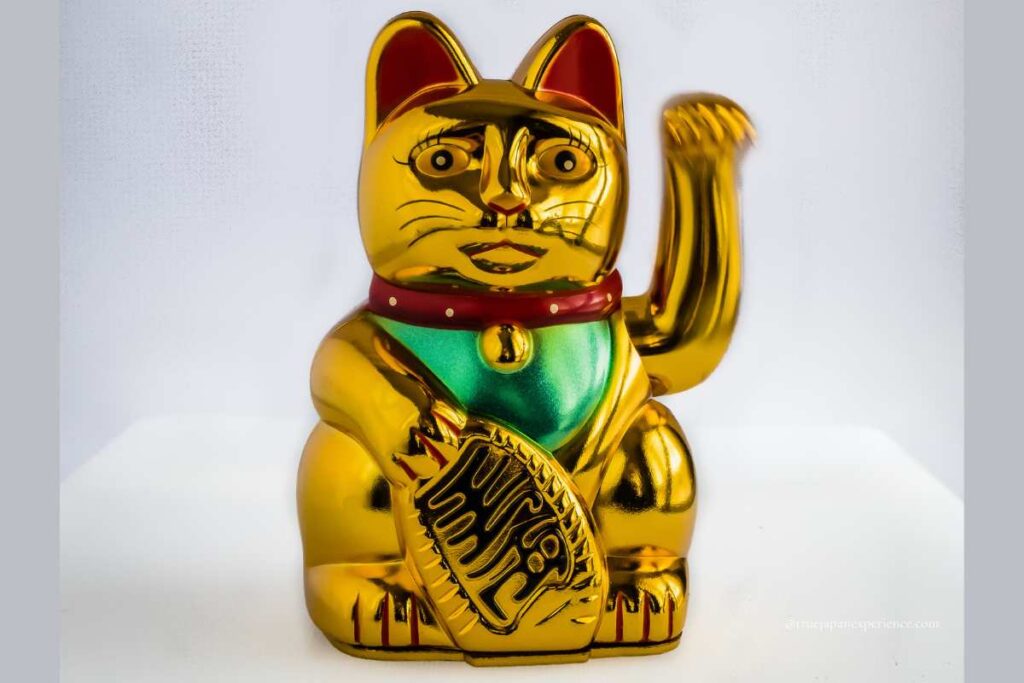
The Maneki-neko is one of Japan’s most famous lucky symbols.
In English, it is also called the “Lucky Cat” or “Beckoning Cat.”
It is a cat statue with one paw (or both paws) raised, as if calling someone to come closer. In Japan, this gesture means “Come in” or “Welcome.” People believe it brings “good fortune” or “good customers” to shops.
You can often see them in shops, restaurants, or at the entrance of homes. They are placed to bring money, good relationships, safety at home, and happiness to the owner.
History and Origin
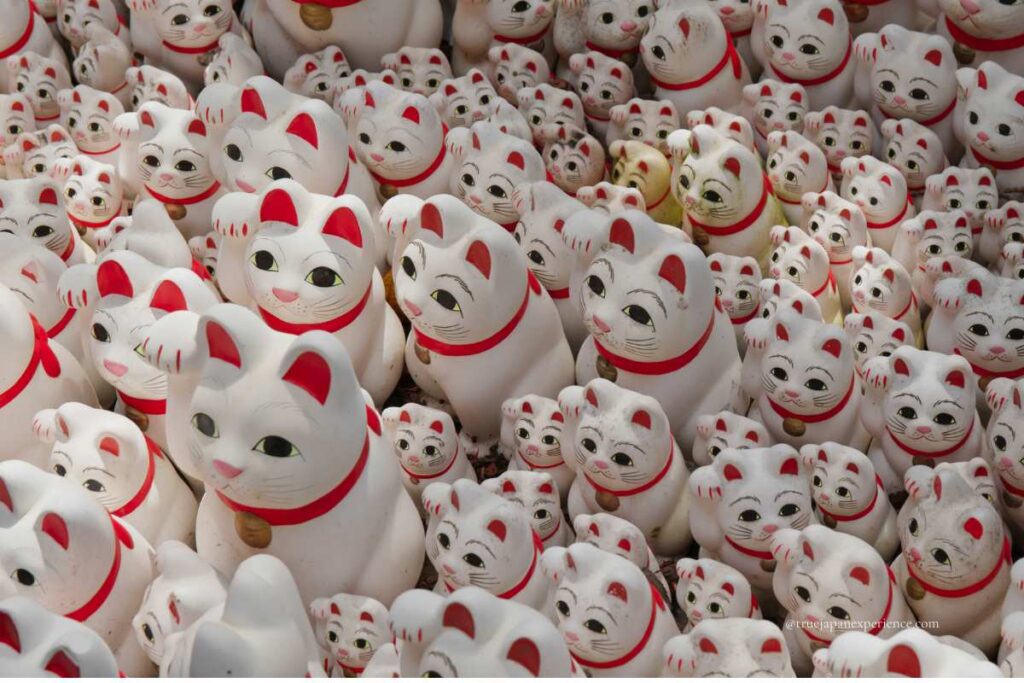
The Maneki-neko began in Japan in the Edo period (17th to 19th century).
There are many stories about how it started. Some people believe it began at Gotokuji Temple in Setagaya, Tokyo.
The story says that a samurai lord named Naotaka Ii was passing by the temple when he saw a cat waving its paw. He went inside, and soon after, a thunderstorm started. The cat had saved him from getting wet. Out of thanks, he helped the temple grow, and the cat became a symbol of good luck.
Another story comes from Imado Shrine in Asakusa, Tokyo.
In this story, a poor old woman had to give up her cat. One night, the cat came to her in a dream and told her to make clay statues of it. She did, and the statues sold well. She became rich, and people began to believe cat statues bring good fortune.
These stories spread because they were connected to business success and good luck.
Shops began placing Maneki-neko to welcome customers. In Edo times, merchant culture grew, and putting lucky items at the entrance became common. This helped spread the Maneki-neko across Japan.
Designs and Meanings of the Maneki-neko
The Maneki-neko is more than just a shop’s lucky charm.
Each detail—from the paw it raises to the color it wears—carries a special meaning. Over the years, people have begun to choose them not only for attracting customers but also for wishes of health, safety, and happiness.
Let’s explore how different designs bring different kinds of luck.
Paw Position
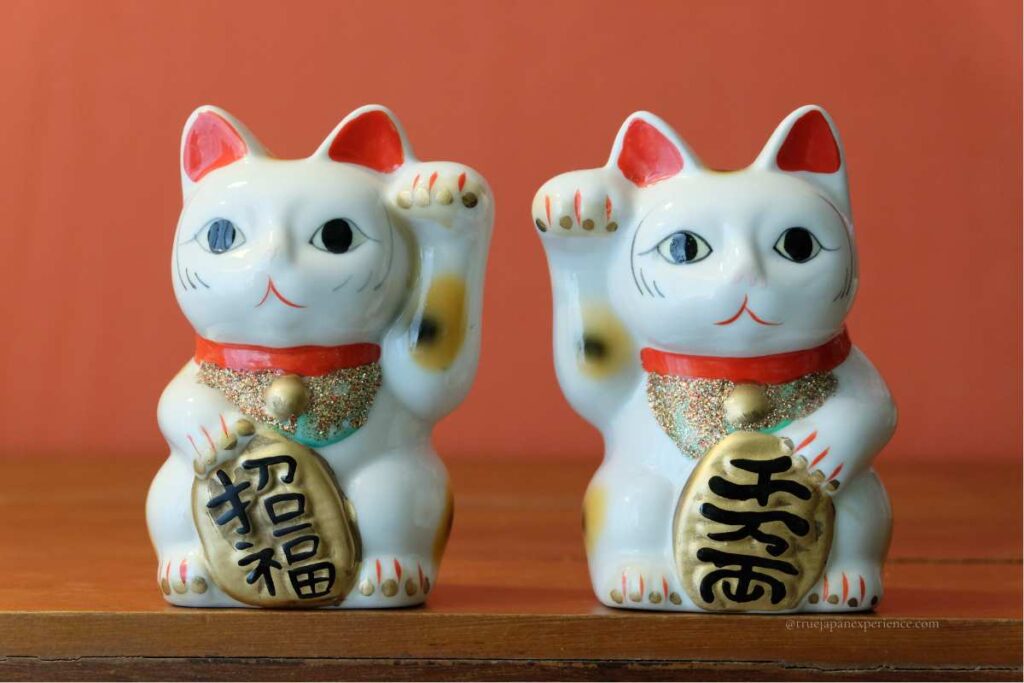
The paw a Maneki-neko raises is not random—it tells you the type of luck it is meant to bring.
Here’s what each one means:
・Right paw up → Brings money and good fortune.
・Left paw up → Attracts people and customers.
・Both paws up → Welcomes both money and people.
In some cases, the height of the paw also changes the meaning.
A higher paw is said to invite luck from far away, while a lower paw draws it in quickly. That’s why you may see many different styles when you visit Japan.
Colors
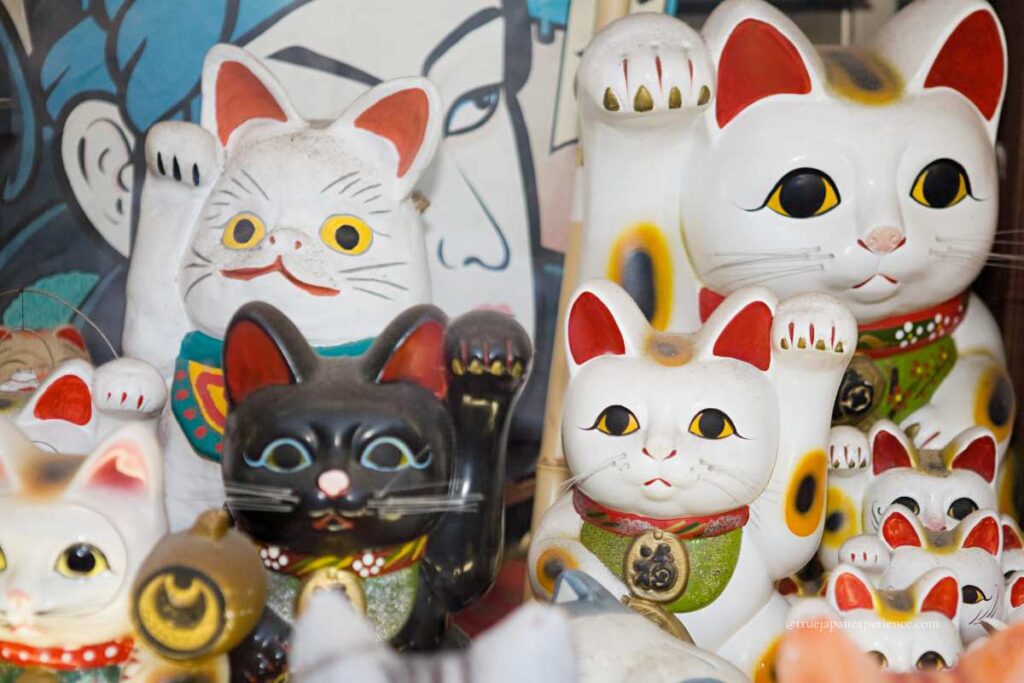
The color of a Maneki-neko is more than decoration—it adds another layer to its meaning. People often choose a color that matches their personal wishes or the type of protection they hope for.
Here are the most common ones you will see:
・Calico → The most traditional, brings general good luck.
・White → Happiness and purity.
・Black → Protection from evil.
・Gold → Wealth and money luck.
・Red → Health and protection from illness.
Some shops and homes even place several colors together to combine their blessings.
Modern versions now come in pastel or vivid shades, adding a playful twist to this traditional charm.
Items in the Paws and Their Meanings
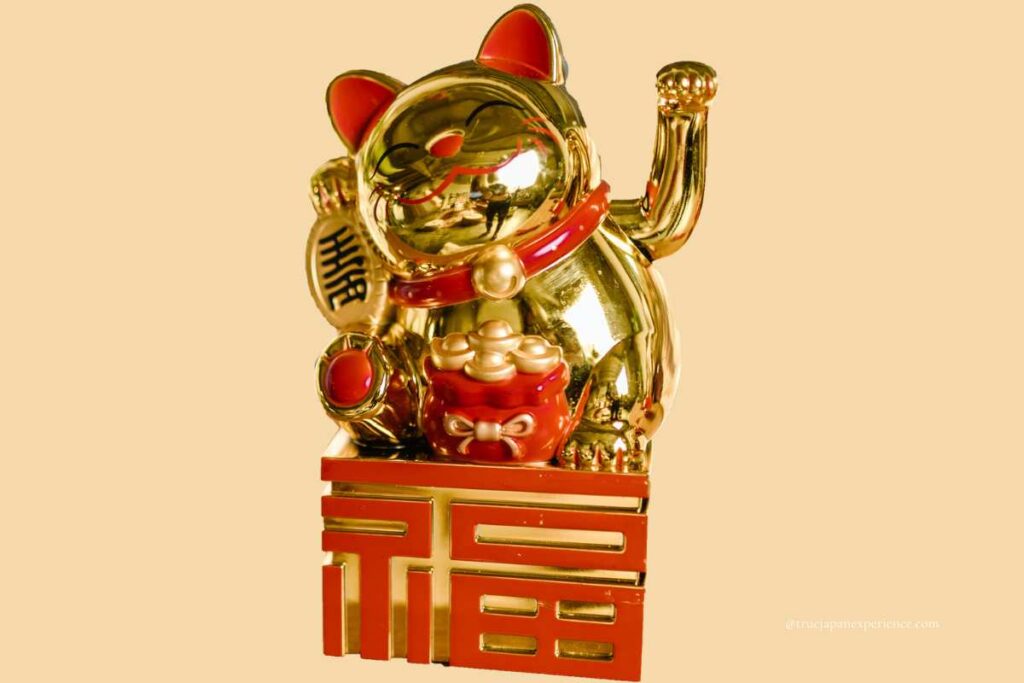
A Maneki-neko often holds something in its paw, and each item carries its own special meaning. These objects add to the charm’s power and make it even more personal for the owner.
Here are some of the most common:
・Koban coin → Money and wealth.
・Tai fish → Happiness (because “tai” means “celebration” in Japanese).
・Magic mallet → Dreams come true and wealth increases.
・Bag of money → Saving and keeping money safe.
・Lucky rake → “Raking in” good fortune.
・Bell → Keeps away bad spirits and brings good luck.
In modern designs, you might also see playful items like flowers, hearts, or even coffee cups, showing how the Maneki-neko continues to evolve while keeping its lucky charm spirit alive.
Nowadays, there are also modern designs with cute faces or bright colors, made for decoration as well as tradition.
The Role of the Maneki-neko Today
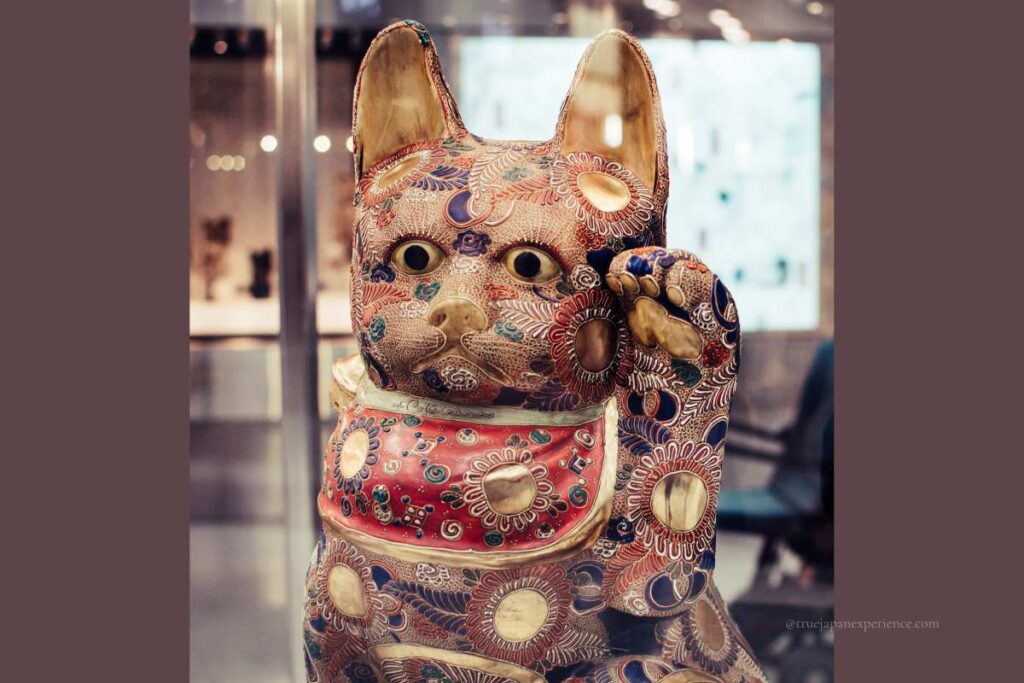
Today, the Maneki-neko is more than just an old tradition. It is part of daily life in Japan.
You see them in shops and restaurants to invite customers and money. Homes display them at the entrance or in the living room to bring peace, health, and good fortune to the family. People also give them as gifts for new houses or new businesses.
They are also symbols of Japanese tradition. For example, Gotokuji Temple has thousands of white Maneki-neko statues offered by people whose wishes came true. In February, during “Cat Day” (2/22), there are events celebrating them.
Designs have become more varied — not just ceramic or clay, but also glass, plastic, solar-powered versions that wave, and even art-style Maneki-neko.
Unique designs often go viral on social media, bringing visitors to the shops or cities where they are displayed. Some companies even use a Maneki-neko as a lucky charm for their office, believing it helps with business success.
Before we finish, let’s take a look at some of the best places in Japan where you can see the Maneki-neko in person and experience its charm up close.
Famous Maneki-neko Spots in Japan
If you love the charm of the Maneki-neko, Japan has many places where you can see them in all shapes and sizes.
Some spots are filled with hundreds of lucky cats, while others let you paint your own or take one home for good luck.
Visiting these places is not only fun but also a unique way to experience Japanese culture and bring a bit of fortune into your trip.
Let’s explore four famous spots that will make any Maneki-neko fan smile.
Gotokuji Temple (Tokyo)
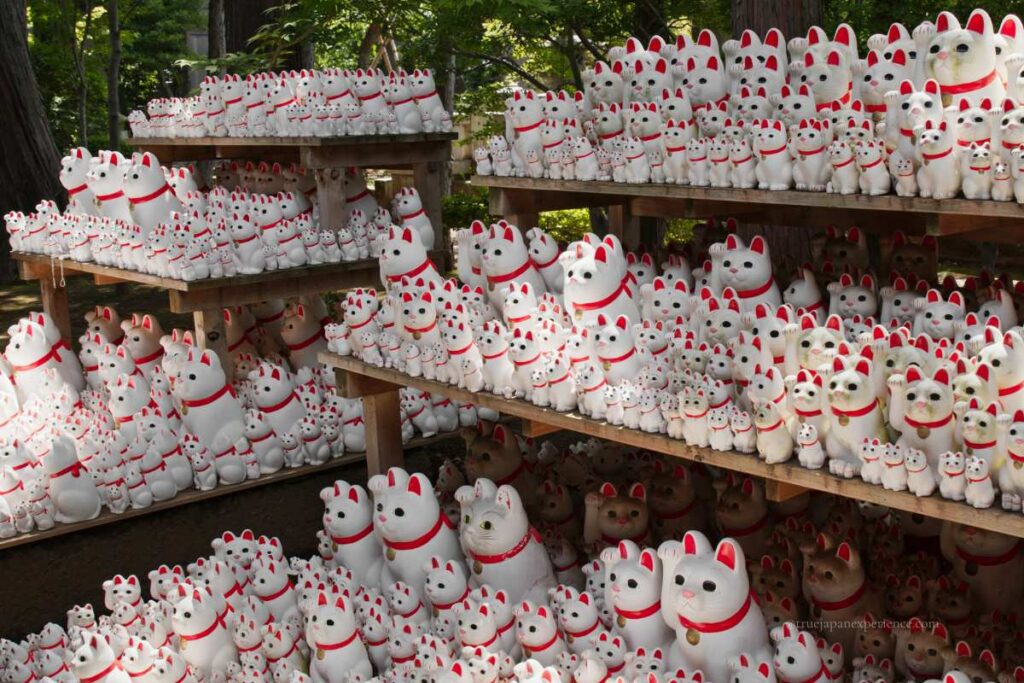
Gotokuji Temple is often said to be the birthplace of the Maneki-neko legend.
Located in a quiet residential area of Setagaya, this peaceful temple is famous for its thousands of white cat statues with raised paws. These figures are offered by visitors after their wishes—often for success, health, or happiness—come true.
As you walk through the temple grounds, you’ll find shelves and corners filled with rows of Maneki-neko in all sizes, creating a heartwarming and almost magical scene.
The temple also has a beautiful three-story pagoda and seasonal flowers, making it a lovely place to slow down and enjoy a moment of calm in the middle of Tokyo.
If you’re curious to explore the birthplace of the Maneki-neko,
check out Gotokuji Temple in Tokyo – a peaceful temple where thousands of lucky cats await your visit.
Imado Shrine (Tokyo)
Imado Shrine, located in the Asakusa area of Tokyo, is closely linked to one of the origin stories of the Maneki-neko.
Today, the shrine is also famous as a place for love and matchmaking. Visitors often come to pray for a happy relationship or to meet a good partner.
You’ll find many cat-themed charms, ema (wooden prayer plaques), and statues around the grounds, making it a charming spot for both history lovers and romantics.
Tokoname City (Aichi Prefecture)
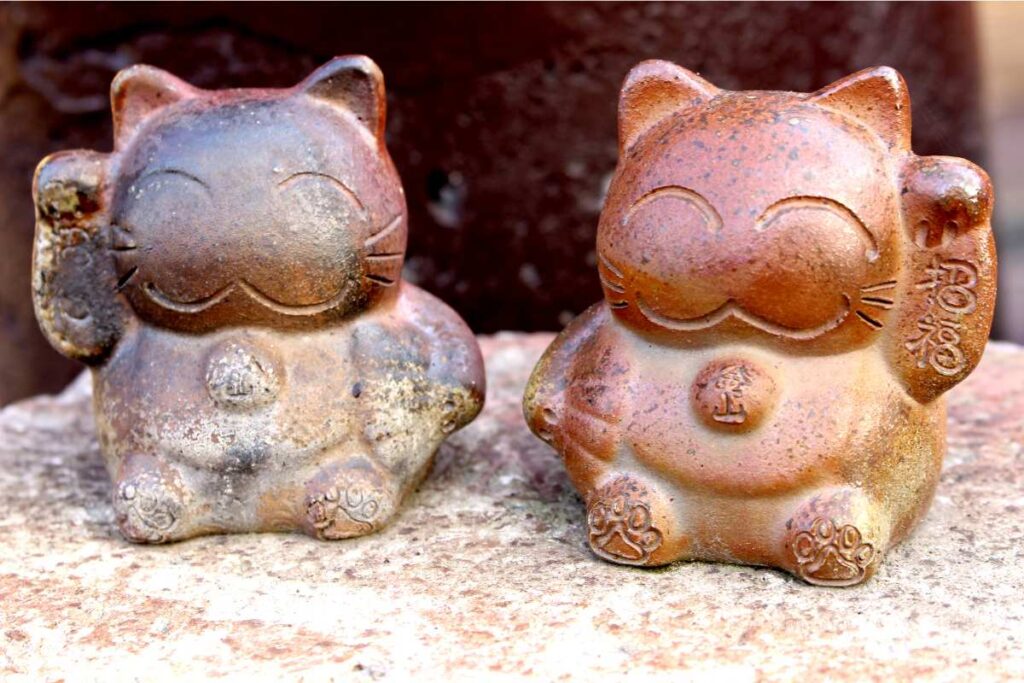
Tokoname City, located on the Chita Peninsula in Aichi Prefecture, is one of Japan’s most famous pottery towns and a major producer of Maneki-neko.
Here, you can meet “Tokonyan,” a giant 3.8-meter cat statue that watches over the city from above a main street. The friendly face of Tokonyan has become a symbol of the town and a popular photo spot.
Another highlight is the “Pottery Footpath,” a scenic walking route lined with walls made from clay pipes and tiles, as well as countless small cat statues peeking out from corners.
Along the way, you can visit pottery studios, shops selling handmade Maneki-neko, and cozy cafés, making it a wonderful destination for both art lovers and cat fans.
Maneki-neko Museum (Okayama)
The Maneki-neko Museum in Okayama is a treasure trove for lucky cat fans.
Inside, you’ll find over 800 Maneki-neko of all shapes, sizes, and colors, collected from across Japan. Each piece reflects the regional style and charm of the area it comes from, offering a fascinating look at how this beloved figure has evolved over time.
One of the highlights is the hands-on painting workshop, where you can design and take home your very own Maneki-neko. It’s a fun way to create a unique souvenir while learning about the culture behind it.
The museum offers plenty of photo opportunities and heartwarming stories to discover.
Let the Maneki-neko Bring You Fortune
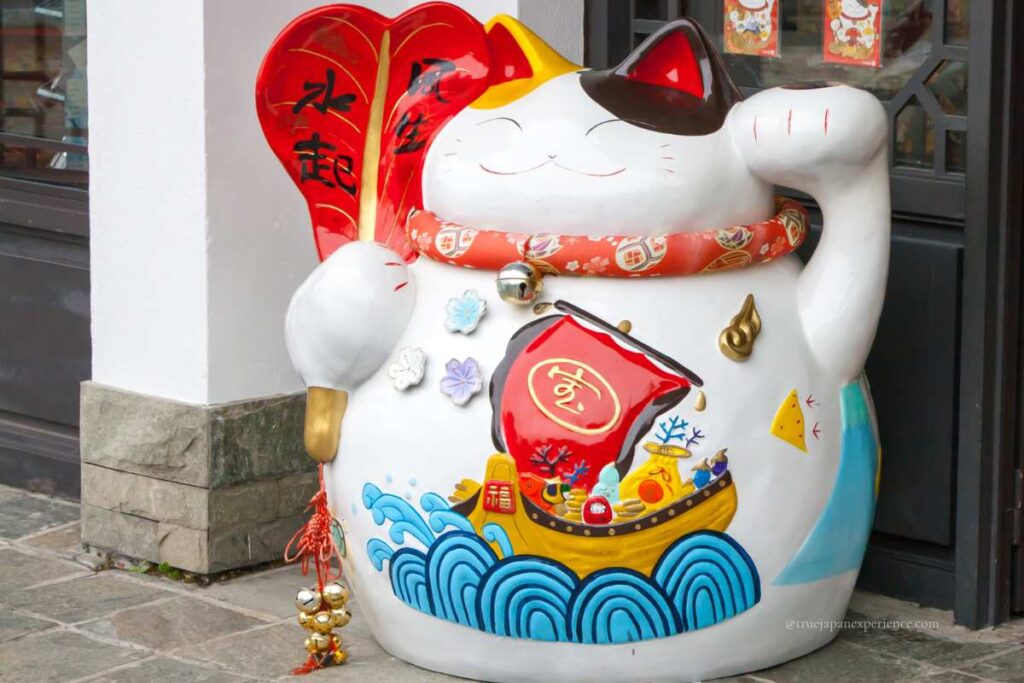
The Maneki-neko is more than just a cute cat statue. It carries stories, history, and the wishes of many people.
In Japan, each Maneki-neko you meet has a different face and a different meaning.
When you visit famous spots, you may discover your own favorite lucky cat.
It can be a fun trip for sightseeing, but also a personal journey to bring a little extra luck into your life.
So next time you see a Maneki-neko, maybe give it a smile — who knows, it might just bring you good fortune!
